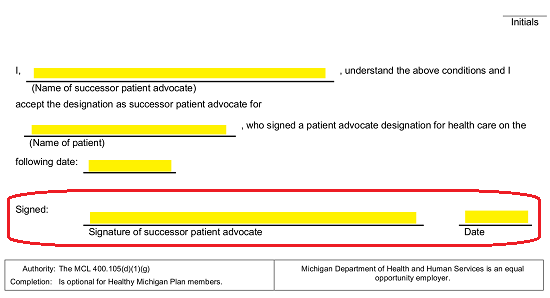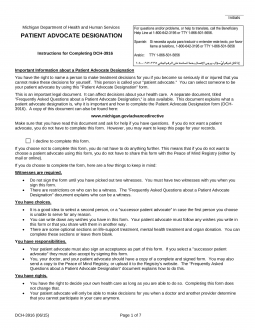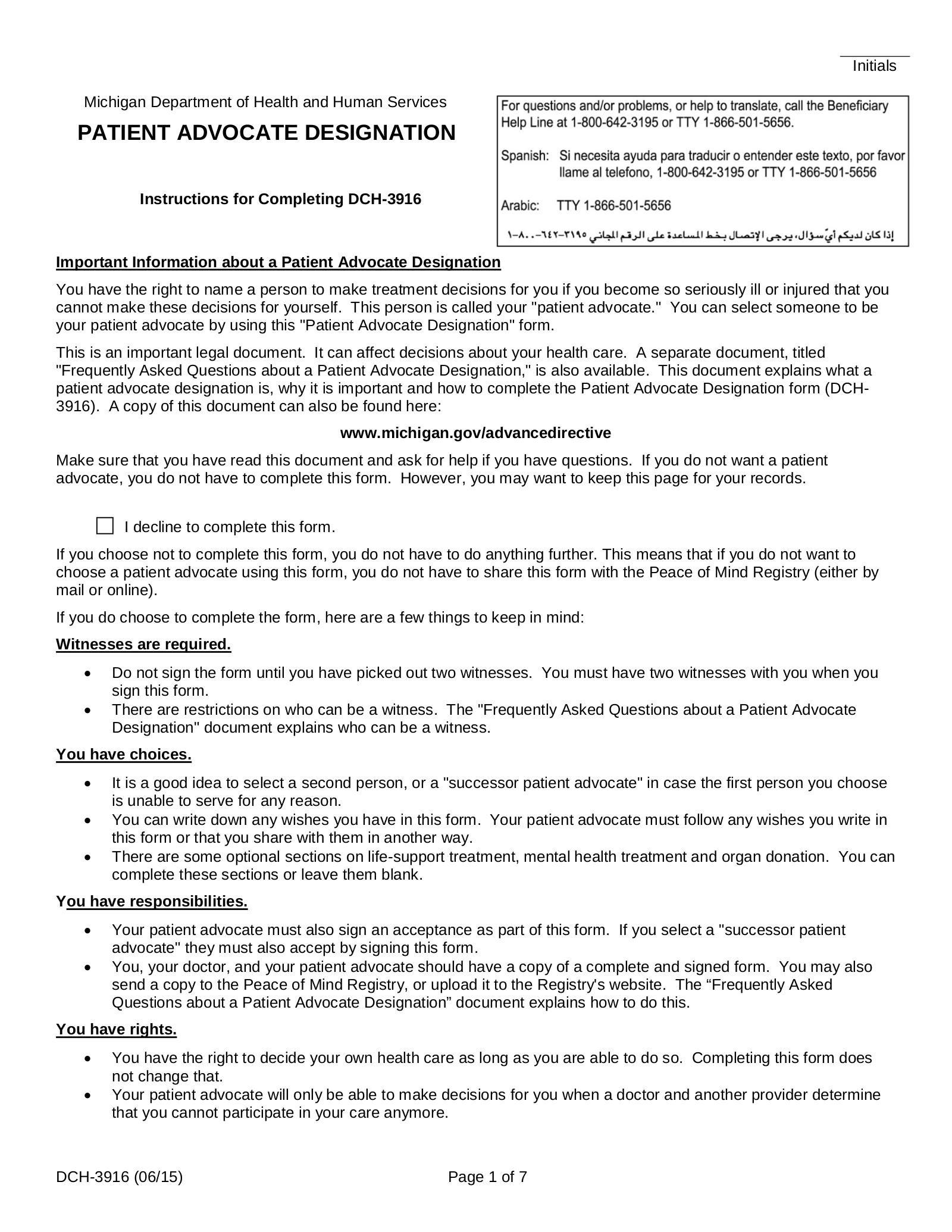Updated June 07, 2023
A Michigan medical power of attorney, or “patient advocate designation,” is a form that allows a patient to appoint an “advocate” to make medical-related decisions on their behalf. The advocate agrees to make decisions in the best interests of the patient. It is recommended that the patient complete a Living Will to enter their treatment preferences in the event of incapacitation.
Laws
- Signing Requirements – Two (2) witnesses (§ 700.5506).
- Statutes – 386-1998-V-5 (Durable Power of Attorney and Patient Advocate)
How to Write
1 – Open This Patient Advocate Form
The button below the preview form image will enable you to open this form as a PDF with a form-friendly browser or a PDF editor. Once you have opened this form make sure to read through it. The Principal will need to initial the top right-hand corner of each page to indicate he or she has read and approves of the information on that page.
2 – Recording The Principal Patient’s Information In The Header
On the first blank line, labeled “Print Or Type Your Full Name,” enter the Principal Patient’s Legal Name. Below this, record the Principal Patient’s “Street Address, City, State, and Zip Code.” Finally, on the last blank line in this header, enter the Principal Patient’s “Date of Birth” on the first empty space and the Principal Patient’s “Last 4 Digits” in his or her Social Security Number on the second blank space. This document will provide the structural wording required for a Principal to designate a Patient Advocate when he or she is a Patient under Medical Care and unable to make his or her own decisions. To begin, record the Name of the individual appointing a Patient Advocate on the first blank space of the main paragraph (labeled “Print Or Type Your Full Name”).
This document will provide the structural wording required for a Principal to designate a Patient Advocate when he or she is a Patient under Medical Care and unable to make his or her own decisions. To begin, record the Name of the individual appointing a Patient Advocate on the first blank space of the main paragraph (labeled “Print Or Type Your Full Name”). ![]() Locate the statement “The person I choose as my patient advocate is,” then use the blank spaces provided to name the individual the Principal wishes to empower to make Medical Decisions on his or her behalf. Enter the Patient Advocate’s Legal Name on the blank line labeled “Name” and Patient Advocate’s “Telephone Number” (i.e. Cell Phone Number) on the adjacent blank space.
Locate the statement “The person I choose as my patient advocate is,” then use the blank spaces provided to name the individual the Principal wishes to empower to make Medical Decisions on his or her behalf. Enter the Patient Advocate’s Legal Name on the blank line labeled “Name” and Patient Advocate’s “Telephone Number” (i.e. Cell Phone Number) on the adjacent blank space.  The line below the Patient Advocate Name you recorded, enter that individual’s Residential Address on the blank line labeled “Street Address, City, State, and Zip Code.”
The line below the Patient Advocate Name you recorded, enter that individual’s Residential Address on the blank line labeled “Street Address, City, State, and Zip Code.”
3 – The Patient Advocate’s General Powers Are Documented For Principal Review
Below the heading “General Powers,” an outline of the manner in which the Patient Advocate may act is provided. The Principal should go through this list and remove any Principal Powers that should be excluded from the Patient Advocate’s Principal Powers.
This list will begin with a checkbox. If the Principal Patient has any religious beliefs that prevent a standard examination, then mark the box preceding the words “My religious beliefs…” Then, report who may determine the Principal Patient’s ability to make Medical Decisions regarding his or her Medical Treatment. ![]()
 The first statement will declare the Patient Advocate obligations to act according to information delivered by the Principal.
The first statement will declare the Patient Advocate obligations to act according to information delivered by the Principal. ![]() The second statement will empower the Patient Advocate to consent or refuse Medical Treatment on behalf of the Principal.
The second statement will empower the Patient Advocate to consent or refuse Medical Treatment on behalf of the Principal. ![]() The third statement grants Principal Patient Approval for the Patient Advocate to access the Principal’s Medical Records and applicable Legal Documents that may be required by Government Programs.
The third statement grants Principal Patient Approval for the Patient Advocate to access the Principal’s Medical Records and applicable Legal Documents that may be required by Government Programs. ![]() The fourth statement allows the Principal Patient to retain the right to change his or her mind regarding this designation at any time.
The fourth statement allows the Principal Patient to retain the right to change his or her mind regarding this designation at any time.
![]()
The fifth statement absolves the Medical Caretakers who honor the Principal Patient wishes defined here in this document from liability for adhering to this issuance.
![]()
4 – The Principal Patient Statement
The section titled “Statement Of Wishes” provides a definitive area for the Principal Patient to directly state his or her preferences, concerns, and limits concerning Medical Treatment. If the Principal chooses not to deliver any specific instructions, then mark the box labeled “I choose not to write…” If the Principal does wish to deliver instructions, mark the box labeled “My wishes are…,” then record the Principal instructions on the blank lines provided. If the Principal Patient does have specifics to report and requires more room, then you may include such instructions in an attachment.
5 – Optional Declarations That May Be Included
Three optional Principal wishes may be declared before the finalization of this form. Each one will have a defined area where the Principal may choose to deliver these Optional Instructions.
The first box, “Power Regarding Life-Sustaining Treatment,” will address the Advocate’s ability to accept or deny Life-Saving or Life Extending Medical Procedures on behalf of the Principal. This includes deciding whether the Principal Patient will accept or deny Artificially delivered Nourishment/Liquids and Resuscitation. If the Patient Advocate should have this Decision-Making Power, the Principal must sign the blank line provided and enter the Date of this signature on the adjacent blank line.  The box labeled “Power Regarding Organ Donation” shall give the Principal the option to specify his or her preferences regarding the subject of anatomical gifts. Any of the check boxes may be marked, making them Principal Instructions. Mark the first check if the Principal will donate organs/body parts for transplants, therapies, and research/education. If the Principal wishes to donate for specific purposes and/or specific body parts, then mark the second box and report such preferences on the blank line provided. If the Principal will donate his or her entire body for anatomical study, then mark the third checkbox. If there is a preference to where the Principal’s Anatomical Gift(s) should be made, then mark the last checkbox and record the Recipient’s Identity and Contact information on the blank space provided.
The box labeled “Power Regarding Organ Donation” shall give the Principal the option to specify his or her preferences regarding the subject of anatomical gifts. Any of the check boxes may be marked, making them Principal Instructions. Mark the first check if the Principal will donate organs/body parts for transplants, therapies, and research/education. If the Principal wishes to donate for specific purposes and/or specific body parts, then mark the second box and report such preferences on the blank line provided. If the Principal will donate his or her entire body for anatomical study, then mark the third checkbox. If there is a preference to where the Principal’s Anatomical Gift(s) should be made, then mark the last checkbox and record the Recipient’s Identity and Contact information on the blank space provided. 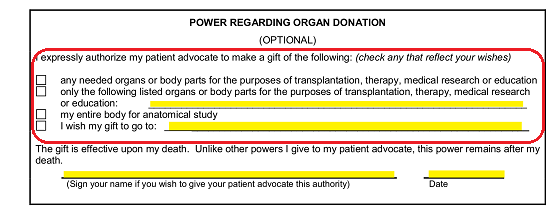 Once the Principal has filled out this box, he or she must sign the blank line and document the Date of Signature.
Once the Principal has filled out this box, he or she must sign the blank line and document the Date of Signature.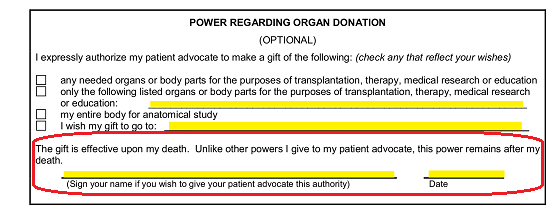
The next box, “Power Regarding Mental Health Treatment,” allows the Principal Patient to discuss his or her preferences regarding Mental Health Decisions the Patient Advocate may have to make. The Principal may empower the Patient Advocate to make decisions regarding his or her Outpatient Therapy, Voluntary Patient Admission, Psychotropic Medication, and Electro-convulsive therapy my marking the checkbox corresponding to the preferred choices. 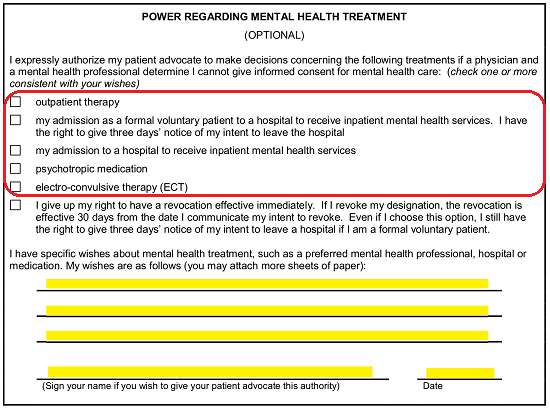 The last checkbox will allow the Principal Patient to relinquish the right to issue an immediate revocation. If the Principal Patient checks this box, all Revocations of this document will be effective no sooner than thirty days of their execution.
The last checkbox will allow the Principal Patient to relinquish the right to issue an immediate revocation. If the Principal Patient checks this box, all Revocations of this document will be effective no sooner than thirty days of their execution.  The Principal Patient may have some very specific preferences and concerns regarding Mental Health Care. If so, this may be reported on the blank lines provided. If required, you may attach a properly titled document continuing the report on these wishes.
The Principal Patient may have some very specific preferences and concerns regarding Mental Health Care. If so, this may be reported on the blank lines provided. If required, you may attach a properly titled document continuing the report on these wishes.  If the Principal Patient has filled out this section, he or she must sign the last blank line and provide the Date of Signature next to his or her name.
If the Principal Patient has filled out this section, he or she must sign the last blank line and provide the Date of Signature next to his or her name.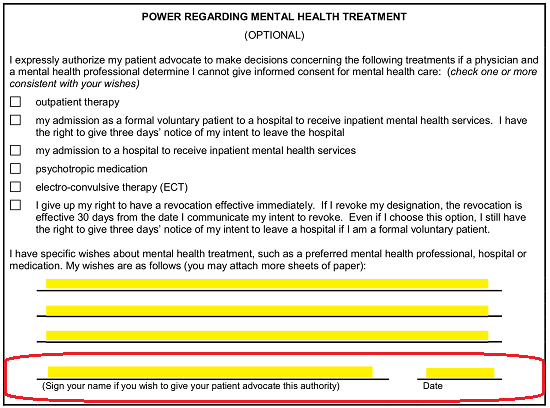
6 – Only Signature Parties May Execute This Form
Locate the “Signature” heading. The Principal Patient must enter the current Calendar Date on the blank line labeled Date, Sign his or her Name on the blank line labeled “Your Signature,” enter his or her current Telephone Number on the blank line labeled “Your Telephone,” and record his or her Residential Address on the blank line labeled “Your Address (Street Address, City, State, and Zip Code.”  The next section may only be satisfied by two Witnesses who have seen the Principal Patient sign the previous section. Each Witness should read the “Statement And Signature Of Witnesses” section then supply the Current Date, his or her Printed Name, Signature, and Address on the blank lines labeled “Date,” “Print Name,” “Signature Of Witness,” and “Witness Address.” Each Witness will have a separate set of blank spaces to satisfy this requirement.
The next section may only be satisfied by two Witnesses who have seen the Principal Patient sign the previous section. Each Witness should read the “Statement And Signature Of Witnesses” section then supply the Current Date, his or her Printed Name, Signature, and Address on the blank lines labeled “Date,” “Print Name,” “Signature Of Witness,” and “Witness Address.” Each Witness will have a separate set of blank spaces to satisfy this requirement. 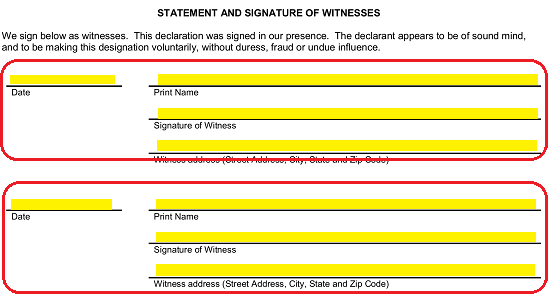 The final area of this document, “Acceptance by Patient Advocate,” will require the attention of both the Patient Advocate and the Successor Agent. Each of these parties should read the text provided here. Then, once this task is complete, the Patient Advocate should Print his or her Name on the blank space labeled “Name of Patient Advocate.” Next, the Full Name of the Principal Patient must be supplied on the blank line labeled “Name of Patient.” The last blank space of this paragraph will require the Principal Patient’s Date of Signature.
The final area of this document, “Acceptance by Patient Advocate,” will require the attention of both the Patient Advocate and the Successor Agent. Each of these parties should read the text provided here. Then, once this task is complete, the Patient Advocate should Print his or her Name on the blank space labeled “Name of Patient Advocate.” Next, the Full Name of the Principal Patient must be supplied on the blank line labeled “Name of Patient.” The last blank space of this paragraph will require the Principal Patient’s Date of Signature.  On the blank line immediately following the word “Signed,” the Patient Advocate must sign his or her Name. Then, on the next blank space, enter the Date he or she signed this form.
On the blank line immediately following the word “Signed,” the Patient Advocate must sign his or her Name. Then, on the next blank space, enter the Date he or she signed this form. 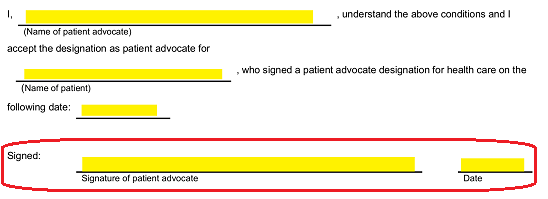 Similarly, the Successor Patient Advocate’s printed Name will need to be supplied on the blank space labeled “Name of Successor Patient Advocate.” The Name of the Principal should be entered on the blank space labeled “Name of Patient.” Lastly the blank space after the words “…following date,” the Principal Patient’s Signature Date will need to be reported
Similarly, the Successor Patient Advocate’s printed Name will need to be supplied on the blank space labeled “Name of Successor Patient Advocate.” The Name of the Principal should be entered on the blank space labeled “Name of Patient.” Lastly the blank space after the words “…following date,” the Principal Patient’s Signature Date will need to be reported 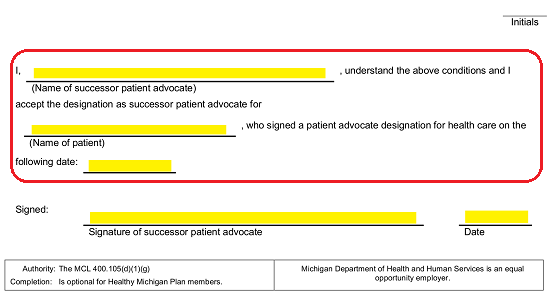 The Successor Patient Advocate must sign the blank line labeled “Signature of Successor Patient Advocate” then, enter the Date he or she signed this form on the blank space labeled “Date.”
The Successor Patient Advocate must sign the blank line labeled “Signature of Successor Patient Advocate” then, enter the Date he or she signed this form on the blank space labeled “Date.”